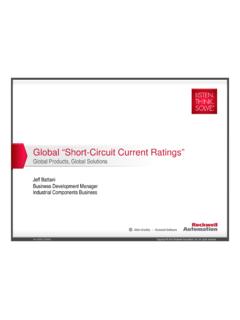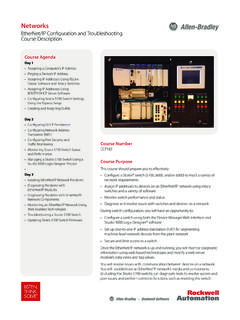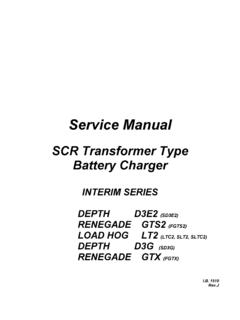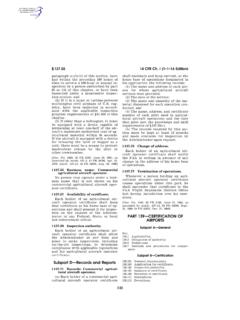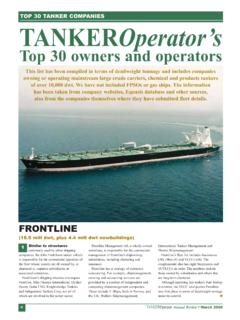Transcription of Proper Graphics for Operator Insert Photo Here ...
1 Copyright 2011 Rockwell Automation, Inc. All rights Photo HereRockwell Automation Process Solutions User Group (PSUG)November 14-15, 2011 Chicago, IL McCormick Place WestThe High Performance HMIP roper Graphicsfor Operator EffectivenessMark CarriganPASA genda PAS Overview The History of HMIs in Industry High Performance HMI Justification Common But Ineffective Process Depictions High Performance Graphic Principles and Elements High Performance Graphic Hierarchy The 7-Step High Performance HMI Development Process SummaryMark Carrigan Vice President, Global Business Development at PAS Roles have included Operations Management Managing Director, PAS Middle East The History of HMIs in Industry High Performance HMI Justification Common But Ineffective Process Depictions High Performance Graphic Principles and Elements High Performance Graphic Hierarchy The 7-Step High Performance HMI Development Process SummaryAbout PASF ounded in 1993 Privately held Texas Corporation Process Automation Solutions Provider 110 People in 9 Offices worldwide Sustainable growth - 300% in 7 yearsBusiness Strategy Focused on long term growth Significant investment in R&D.
2 >20% of annual revenue Ten-year plan on software & technologyIndustry Organizations & Strategic Partners EPRI, ISA, AICHE, NPRA, EMMUA 191 Regional engineering firms PAS Solutions Improve Disturbance Rejection Minimize Operator Loading Optimize Situational Awareness Enable Accurate Operator Actions Expand Layers of Protection for SafetyOperations EffectivenessAchieve Superior Operator Performanceand Reduce Vulnerabilitiesduring abnormal situations and steady state EffectivenessMap the Automation Genome and expose new possibilities for knowledge retention, collaboration, and decision support. Retain Important Plant Knowledge Provide a Collaboration Platform Enable Change Tracking/Defect Detection Provide Disaster Recovery Ensure Accurate Documentation Realize the Full Potential of Your People and Automation SystemsCopyright 2011 Rockwell Automation, Inc. All rights Photo HereRockwell Automation Process Solutions User Group (PSUG)November 14-15, 2011 Chicago, IL McCormick Place WestThe High Performance HMI: Proper Graphicsfor Operator EffectivenessThe HMI of the Past Provided the Big Picture Limited Capability Many Process Trends Status at-a-glance Equipment StatusProcess ValuesHuman PerceptionAlarmsThe DCS Arrives The Keyhole View Expensive Screens Contributed to over-alarming Lost the Big Picture Early Group Display showing 8 sensorsDCS Graphics Introduced But No Guidelines!
3 Poor Graphics Encourage Poor Operating PracticesCommon HMI DepictionsCommon, but ineffectiveprocess depictions! Numbers sprinkled on a screen Inconsistent, improper use of colorNo trendsNo condition informationAnd Even Worse Vendor Improved Graphic Capability yields even worse 10% of the screen is used to show poorly-presented numeric data, 90% is a just a pretty picture Other Industries Do It Better Speed Altitude Position Course Time Enroute Time to next Waypoint Time to Destination Fuel Remaining Proximity to Ground Proximity to Rising Terrain Nearby Airports Positions of nearby aircraft Real-time weather & lightning Glide Radius Engine diagnostics Data on Available Services at Airports Comm & Nav Frequencies Instrument Approaches Lots more!GARMIN 1000 Avionics SystemThe High Performance HMIS tudy by Nova Chemicals and ASM ConsortiumTaskWith Traditional HMIWith High Performance HMII mprovementDetecting Abnormal Situations Before Alarms Occur10% of the time48% of the timeA 5X increaseSuccess Rate in Handling Abnormal Situation70%96%37% over base caseTime to Complete Abnormal Situation min41% reduction$800,000 per year savings anticipated on 1 ethylene plantTime after time, poor HMIs are cited as contributing factors to major accidents!
4 Texas City BP HMI a Contributing Factor No Overview No trends No condition indication Essentially just a P&ID segment sprinkled with live values. No material balance (FLOW IN and FLOW OUT are on different Graphics ) Inconsistent colors and alarmsImage taken from the CSB reportData is Not Information: Is Fluffy Sick?Blood Tests for Fluffy 6 x109 x109/ x109/LPLT310 x109/LAnswer: Unless you are vet, how can you know?What About Now?After awhile, you might figure it Tests for Fluffy 6 - x109 x109 x109 x109/L175 - 500 How About Now?ABNORMAL VALUES can be seen at a Tests for Fluffy -3 TestResultsRangeIndicatorLow Normal - 6 - x109 x109 x109 x109/L175 - 500 Data is Not Information: Common XYZ ABC DP INH2012-15 XYZ ABC DP INH2012-15 MPPHMost Graphics in the world basically look like this!
5 Lots of Data Not Much Information Poor Presentation High Mental Workloadto Decipher Cannot grasp what is going on at-a-glance Analog in Industrial ExamplesA Column Temperature ProfileDeviation or absolute numbers optionally + + goodprofile?Yes, this one hot at the top, too cold at the bottomOptional:Line color indicates abnormality, alarm is not yet activatedP&IDs are not HMIs: A Poor ParadigmTypical P&ID Process Pictorial a low performance, overused paradigmWestEastDrive: Vibration: Vibration: psigOil FOil FInformation is Data in Context Made UsefulFLOWRECYCLE COMPRESSOR Indicator Appears here with Priority Level and ColorDesirable Operating Range shown as dotted linesAlarm Range depicted and (for some) shutdown valueAlarm Range depicted and (for some) shutdown or interlock initiatorShow ValuesShow TrendsButtons for additional Status Showing Alarm/Shutdown LimitsAnalog is PowerfulAnalog Indicators with values, direction, and historyOptional Enhancements for Moving Analog variability in the last direction rolling 10 in Industrial ExamplesMaterial Balance IndicatorsScrubber Material WarningDiff: : : 06/02/07 14:00:00 Material WarningDiff: : : 06/02/07 14:00:00 in Industrial ExamplesMaterial Balance Indicator AnimationScrubber Material WarningDiff: : : 06/02/07 14:00.
6 00 Importance Of TrendsCurrent PressureAlarm LimitShutdown psig250 psig300 psigShutdown-2 HRS25030020015010050 AlarmShutdown-2 HRS25030020015010050 AlarmShutdown-2 HRS25030020015010050 AlarmShutdown-2 HRS25030020015010050 AlarmShutdown-2 HRS25030020015010050 AlarmShutdown-2 HRS25030020015010050 AlarmValueNeedingTrendVery Different Situations that only trends can show!The Importance Of mph % Steam#7 RHP COLUMNFeed Temp Deg Flow Temp Deg % Steam HOURST oggle OUTPUT Proper Auto-ranges Show boundaries of What is good Custom Elements for StartupsAlways try to clearly depict: Where am I? How am I doing vs. what is good? Reactor 7 Startup0 TemperatureDeg C+30+60+ PrinciplesPoor Vessel and Line Depiction !Crude Feed TK-21 CRUDE FEED TK-21 Better Vessel and Line DepictionPROD TANKSCRUBBERTo ScrubberTo Product TankNot a navigation targetNavigation target Don t get fancy Avoid 3-D objectsProper Level Depiction Poor Vessel Level IndicationBetter Vessel Level IndicationVery Poor Vessel Level IndicationCrude Feed TK-21 Trend Vessel Level Indication2 HrsSimple, Non-Distracting Element DepictionCRUDE FEED Output %numbers can be more effective than tiny scalesTinyIllegible ScalesTinyIllegible ScalesStatus DepictionBright saturated color is used to indicate abnormal situations only(Shape is Unfilled and darker)Pumps with Run Indication Sensor:WrongBetterPumps without Run Indication Sensing have a fill matching the background:Not RunningRunningWrongBetterSTOPPEDRUNNING( Shape is Filled and lighter)Basic Principles - HierarchyHIERARCHY for Displays.
7 Level 1 Process Area Overview Entire Operator Span of Control. Single-Glance Level 2 Process Unit Control Sub-unit controlled by Operator Level 3 Process Unit Detail Equipment or controller Level 4 Process Unit Support and Diagnostic Displays Interlocks, ESDs, diagnostic screens, etc. Proper Hierarchy minimizes the number of physical screens and makes for Proper navigation Graphics designed from P&IDs will not accomplish a Proper hierarchy!Level 1 Process AreaOverview DisplayLevel 2 Process UnitControl DisplayLevel 2 Process UnitControl DisplayLevel 2 Process UnitControl DisplayLevel 3 Process UnitDetail DisplayLevel 3 Process UnitDetail DisplayLevel 3 Process UnitDetail DisplayLevel 4 Process UnitSupport DisplayLevel 4 Process UnitSupport DisplayLevel 4 Process UnitSupport DisplayReactor 1 ThioniteMid-RunONCLEARProd:State:Agit:Lo cks:Run Plan:Actual:INOUTB alanceMenusMainMenuFeedSysAuxSysReactor1 L2 Trend ControlComp A Comp HRCoolCPCCRMRateReactor 2 CRM-114 Mid-RunONCLEARProd:State:Agit:Locks:Run Plan:Actual:BalanceComp A Comp HRCoolCPCCRMRateINOUTH ydrog ABedA1 BedA2 SuctDschOKOKOKCLEARVIB:BRG:OIL:Locks:Cyc leComp A470500 FLOW2 HRHydrog BBedB1 BedB2 SuctDschOKOKOKCLEARVIB:BRG:OIL:Locks:Cyc leComp B470500 FLOW2 HRAlarms.
8 ACKUNACKT oggleList /SummaryP100P210P321P441 Reactor2 HydrogAHydrogBL3L47080%12 HRKey Performance IndicatorsConversion HREmissions Limit RatioFeed A Feed BFeed C SynGFeed SystemAux SystemsAtv 1 Atv 2 Pres%IPClrT-InT-Out ViscCWTCWPS10 PWRVentPVentTC57 DNull-AJup2S200 MGAGrok22071608 08:55:07 RX2 LOW CRM QUALITY EXCLVLLVLR eactor 1 ThioniteMid-RunONCLEARProd:State:Agit:Lo cks:Run Plan:Actual:INOUTB alanceMenusMainMenuFeedSysAuxSysReactor1 L2 Trend ControlComp A Comp HRCoolCPCCRMRateReactor 2 CRM-114 Mid-RunONCLEARProd:State:Agit:Locks:Run Plan:Actual:BalanceComp A Comp HRCoolCPCCRMRateINOUTH ydrog ABedA1 BedA2 SuctDschOKOKOKCLEARVIB:BRG:OIL:Locks:Cyc leComp A470500 FLOW2 HRHydrog BBedB1 BedB2 SuctDschOKOKOKCLEARVIB:BRG:OIL:Locks:Cyc leComp B470500 FLOW2 HRAlarms:ACKUNACKT oggleList /SummaryP100P210P321P441 Reactor2 HydrogAHydrogBL3L47080%12 HRKey Performance IndicatorsConversion HREmissions Limit RatioFeed A Feed BFeed C SynGFeed SystemAux SystemsAtv 1 Atv 2 Pres%IPClrT-InT-Out ViscCWTCWPS10 PWRVentPVentTC57 DNull-AJup2S200 MGAGrok22071608 08:55:07 RX2 LOW CRM QUALITY EXCLVLLVLL evel 1 Overview At-A-Glance Status FeedMain Feed 1 Additive 1 2 Additive 2 SYSA nalysis: Purity % : Inhibitor Concentration % M5 Pump Level % CTo CoilsCOOLING Plan:Actual:FREEZEM5 INResetOUTCalc Diff:-10%+10%Hours: :State:1970719301 Material 14:00:00 ISOLATEM5 Pump 2 STOPPED2-BADM4 MainMenu- Level 3 -M5 InterlocksFeedSystemProduct RecoveryLevel 1 ReactionOverviewM5 Sequence CapacityM5 StartupOverlayM6- Level 3 -M5 Cooling SystemFeed Components.
9 A - B - C+/- 5 psi, 2hr+/- 1 %, 2hrTrend Control4 Level 2 Process Unit ControlLevel 3 Process Unit CWest Comp Discharge Temp CompMainMenuOHSystemProduct RecoveryCompressionLevel 2 West Sequence OverlayWest StartupOverlayComp Cooling SystemTrend StgpsiEAST COMP2 / HIDE VALUESCLRInSPEED CASCADEIN Compressor Interlock W-1 OverspeedOr Winding Temp High Or Vibration HighOr 1 Stg High PresOr 2 Stg High PressOr Suction Pres LowOr Oil Pres LowInitiatorActionValueStatusOKOKOKOKOKO KOKShut Down West Comp AND Close Inlet & Outlet Block ValvesANDO verride East Comp Speed to 100%West Comp Flow Comp Speed % Level 4 -ProceduresRECOVERYIDLEWESTCOMPPURGEWEST COMPWest CWest Comp Discharge Temp CompMainMenuOHSystemProduct RecoveryCompressionLevel 2 West Sequence OverlayWest StartupOverlayComp Cooling SystemTrend StgpsiEAST COMP2 / HIDE VALUESCLRInSPEED CASCADEIN
10 Compressor Interlock W-1 OverspeedOr Winding Temp High Or Vibration HighOr 1 Stg High PresOr 2 Stg High PressOr Suction Pres LowOr Oil Pres LowInitiatorActionValueStatusOKOKOKOKOKO KOKShut Down West Comp AND Close Inlet & Outlet Block ValvesANDO verride East Comp Speed to 100%West Comp Flow Comp Speed % Level 4 -ProceduresRECOVERYIDLEWESTCOMPPURGEWEST COMPWest Compressor7 Steps for Creating High Performance DisplaysStep 1: Develop a High Performance HMI Philosophy and Style GuideStep 2: Assess and benchmark existing Graphics against the HMI Philosophy Step 3: Determine specific performance and goal objectivesfor the control of the process, for all modes of operationStep 4: Perform task analysis to determine the control manipulations needed to achieve the performance and goal objectivesStep 5: Design and build high performance Graphics , using the design principles in the HMI Philosophy and elements from the Style Guide, to address the identified tasksStep 6: Install, commission, and provide training on the new HMIStep 7: Control, maintain, and periodically reassess the HMI performanceStep 1: Philosophy and Style Guide Philosophy: the overall principles for creating the HMI Philosophy includes information about the consoles and control room practices.
